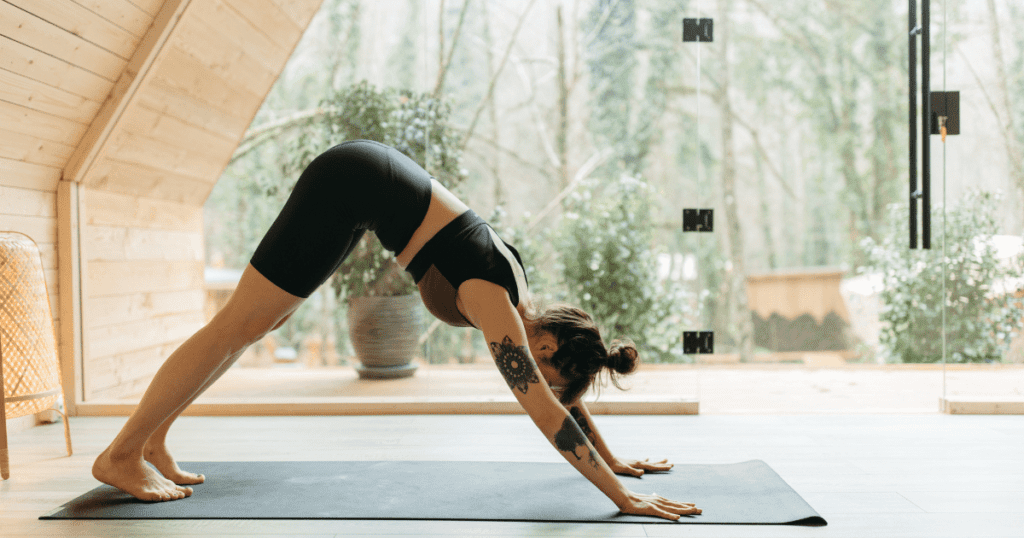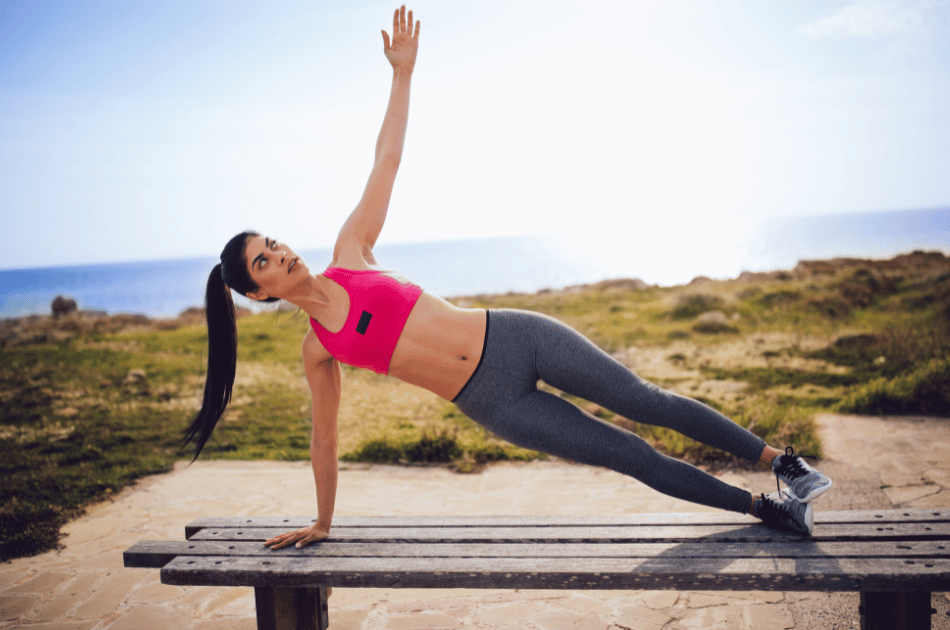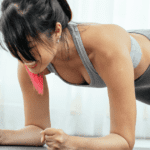My yoga journey began about 25 years ago. My now husband and I attended classes a couple of nights a week at the gym up the street. I remember thinking my wrists and arms couldn’t bear one more down dog about halfway into the classes. That got better over time, but it was an adjustment at first. One of the things you learn early on in yoga is to let go of your attachment to the ego. Your ego may want to get a pose perfect or push through an uncomfortable pose, but it’s more important to listen to your body. This was an important reminder for me to stop when I needed to and relax in child’s pose until I felt ready to get back into the practice. So if you’re feeling uneasy about joining a class as a beginner – don’t fret. Yogis understand that everyone is at a different level in their practice and modifications to poses are the norm. In fact, the instructor will normally give two or three different versions of a pose to meet each student where they are in their practice.
Over the last 25 years, I can’t say that I’ve been consistent with my practice. I’ve mostly focused my fitness routine on high-intensity interval training. But I have at least practiced several times a year and always have good intentions of increasing my frequency. I have suffered from back pain most of my adult life due to gymnastics and a fall. I’ve been to chiropractors, tried regular massages, heating pads, ice packs, you name it. The absolute best way I’ve found to alleviate my back pain is through yoga. Its focus on alignment, core strength, and lengthening of muscles has been the perfect trifecta in getting rid of my pain.
A question many of you may have is whether yoga can be an effective exercise for weight loss. Below, I’ll lay out the different types of yoga, which are most effective for weight loss, and some resources to get you started on your journey.
Note: This post contains affiliate links. I earn a small commission when purchases are made through these links at no additional cost to you.

Most popular types of Yoga
There are at least 13 different types of yoga. I’ll cover the seven most popular ones here.
Hatha yoga
Hatha yoga is a gentle and slow-paced style of yoga. It allows the body to become stronger while calming the mind. Hatha focuses on breathwork and relaxation. It includes poses designed to strengthen and stretch muscles while also increasing flexibility. The benefits of Hatha yoga include improved posture, balance, strength, concentration, stress relief, and better sleep.
Ashtanga yoga
Ashtanga yoga is a dynamic practice that focuses on connecting breath to movement. It consists of six series with progressively more difficult poses and postures, making it an excellent practice for those looking for an intense workout. The benefits of Ashtanga yoga include improved focus, balance, strength, flexibility, energy levels, and improved cardiovascular health.
Bikram yoga
Bikram yoga is a form of hot yoga in a room heated to 105 degrees Fahrenheit. This intensity helps to increase flexibility, stamina, strength, and mental focus. The benefits of Bikram yoga include increased weight loss, improved digestion, detoxification of the body’s system, better posture, and improved sleep.
Iyengar yoga
Iyengar yoga is a practice that focuses on the exact alignment of the body during postures and poses. It uses props such as blankets, blocks, and straps to help practitioners achieve perfect form while holding poses for an extended period. The benefits of Iyengar yoga include improved strength, balance, flexibility, focus, and mental clarity.
Kundalini yoga
Kundalini yoga is an ancient practice that focuses on awakening the kundalini energy located at the base of the spine. It combines postures and poses with breathwork, chanting, and meditation to free up this energy throughout the body. The benefits of Kundalini yoga include improved spiritual awareness, increased energy levels, better concentration, and improved physical health.
Restorative yoga
Restorative yoga is a practice that focuses on the use of props to hold poses for an extended period. It helps to relax both the body and mind while encouraging deep healing and restoration. The benefits of Restorative yoga include improved circulation, relaxation, stress relief, and an improved immune system.
Yin yoga
Yin yoga is a practice that focuses on stretching the connective tissues of the body to increase joint mobility, improve flexibility, and decrease stress levels. This practice requires longer holds of postures as opposed to more dynamic moves. The benefits of Yin yoga include improved flexibility, increased energy levels, better posture, and improved mental clarity.

Is it possible to lose weight with yoga?
Yoga has long been touted as a great way to reduce stress, increase flexibility, and improve overall health. But can it also help you lose weight? The answer is yes!
Research shows that when combined with healthy eating habits, yoga can be an effective tool for weight loss. That’s because practicing yoga regularly increases your heart rate and helps you burn more calories than if you’re inactive. Additionally, the poses require some strength and balance which can further help boost metabolism and burn fat. Furthermore, many forms of yoga encourage mindfulness; helping people to become aware of their bodies and better understand how certain foods make them feel.
When trying to lose weight with yoga, there are specific types of classes that are better than others. Ashtanga and vinyasa yoga classes provide a great combination of strength, flexibility, and cardio. These styles move quickly and often include poses that require balancing on one foot or arm which helps to burn more calories. Power yoga classes also offer a combination of strength building, stretching, and cardio while using bodyweight exercises like squats and push-ups to help build lean muscle mass.
One study showed that even regularly practicing restorative yoga can result in a modest amount of weight and subcutaneous fat loss over six months. One explanation may be that restorative yoga reduces the stress hormone cortisol, which is known to increase abdominal fat. While the results didn’t lead to significant weight loss, this is a good option for those women with limited mobility. For those without limited mobility, other forms of yoga mentioned above will be more effective at losing weight quicker. However, working in one restorative yoga practice a week is a good idea for improving flexibility.
If weight loss is the primary goal of your fitness routine, it’s best to incorporate other types of workouts in addition to yoga. High-intensity interval training is one of the most efficient ways to burn fat and lose weight. (Read here to learn the 3 best exercises to lose belly fat.)

What you need to get started with yoga.
You don’t need a lot of gear to get started with yoga. The most basic requirement is a good yoga mat. I found these high-quality yoga mats at Manduka. Their design approach is rooted in conservancy. They use responsibly sourced materials while minimizing environmental waste. And – they’re designed by yogis who know what makes for a great yoga mat!
If you choose to practice Iyengar yoga you’ll also want to have a blanket, some blocks, and a strap.
You’ll also want to ensure you have breathable, flexible bottoms like pants or shorts. You’ll also need a sports bra and, if you prefer, a breathable narrow or form-fitting top. If you wear a loose top, you’ll regret it during your first down dog!
Lastly, if you’d like to start for free there are a ton of YouTube videos. The most popular is Yoga with Adrienne. She has hundreds of videos to choose from depending on how much time you have for your practice, any areas you want to focus on (like core or back), and different ranges of intensity.
Try these Yoga core strengthening poses at home.
Boat pose
Boat pose is an effective core-strengthening exercise that targets the abdominal muscles and the lower back. To do this exercise properly, start by sitting down on the floor with your legs bent and feet flat on the ground. Place your hands behind you with your palms facing down to provide extra stability. Draw your navel in and up towards your spine while raising both legs off of the floor. Keep your torso straight; if it begins to droop, keep lifting from the abdominals. Hold this pose for 30 seconds and repeat 3-4 times for an effective workout. Boat pose increases muscular endurance in the core as well as strengthens both obliques and rectus abdominis muscles.
Balancing table pose
Balancing table pose is a great exercise to strengthen the core, arms, and legs. To do this yoga pose properly, start by sitting on your knees with your palms flat on the ground behind you. Lift your hips up while balancing on your toes, extending both arms in front of you at shoulder height. Keep the abs engaged and hold for 30 seconds before releasing. This pose should be repeated 3-4 times for an effective workout. It increases upper body strength as well as strengthens abdominal muscles like the rectus abdominis, transverse abdominus and obliques.
Side plank
The side plank is an excellent exercise for strengthening the core muscles including the internal and external obliques, rectus abdominis, and transverse abdominals. To do the pose properly, start by lying on your right side with your left foot crossed over your right. Place your right hand directly under your shoulder and lift both hips off of the floor. Keep the arms straight with elbows slightly bent and hold for 30 seconds before repeating on the other side. For an effective workout, repeat 3-4 times per side.

Windshield wiper
The windshield wiper is a great exercise for strengthening the core muscles as well as stretching out tight hip flexors. To do this exercise properly, lie on your back with your legs extended in front of you at a 90-degree angle from the torso. Slowly bring both feet up to one side and then down to the other side, making sure to keep your abs engaged throughout the entire movement. Make sure to maintain a nice and steady rhythm for at least 30 seconds before repeating 3-4 times. Windshield wiper increases muscular endurance in the core as well as strengthens both obliques and rectus abdominis muscles.
By doing these exercises properly regularly, you will be able to strengthen your core muscles and improve your overall fitness levels. Additionally, engaging in proper stretching beforehand can help reduce any risk of injury which is essential for a safe and effective workout routine. Incorporate boat pose, balancing table pose, side plank, and windshield wiper into your weekly routine to see maximum results!
Summary
Yoga can be an effective part of any fitness routine if practiced regularly with proper form. It’s important to remember that the key to losing weight is burning more calories than you consume, so healthy eating habits should always accompany your practice for it to truly be effective. Additionally, it’s important to listen to your body and not push yourself too hard to avoid injury. With the proper technique and dedication, yoga can be an effective way to help you reach your weight loss goals.
This post may contain affiliate links. I may earn a small commission when you purchase through the links at no additional cost to you.
If you have any health conditions such as an injury or high blood pressure, talk to your doctor before starting any new exercise program.


